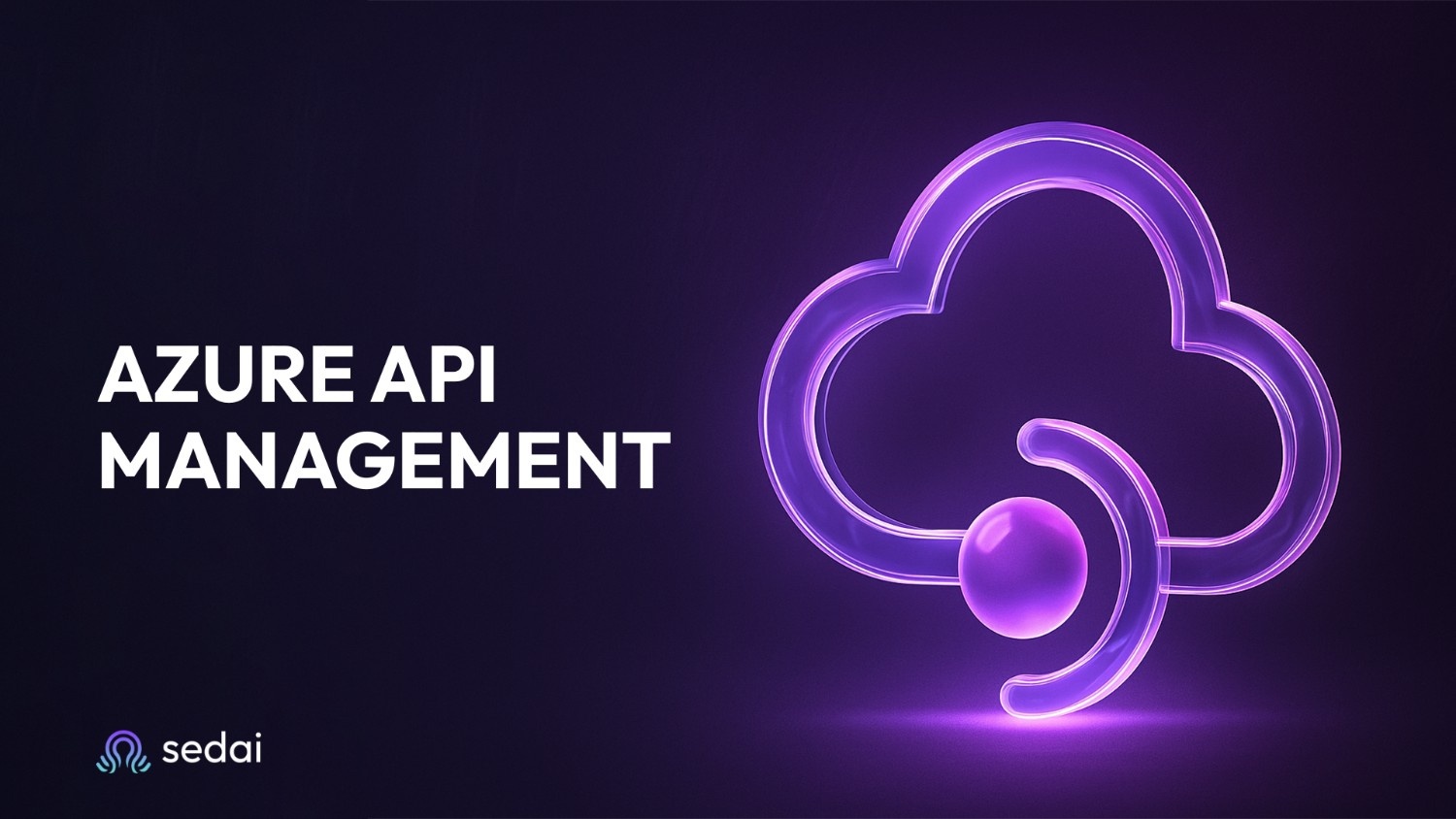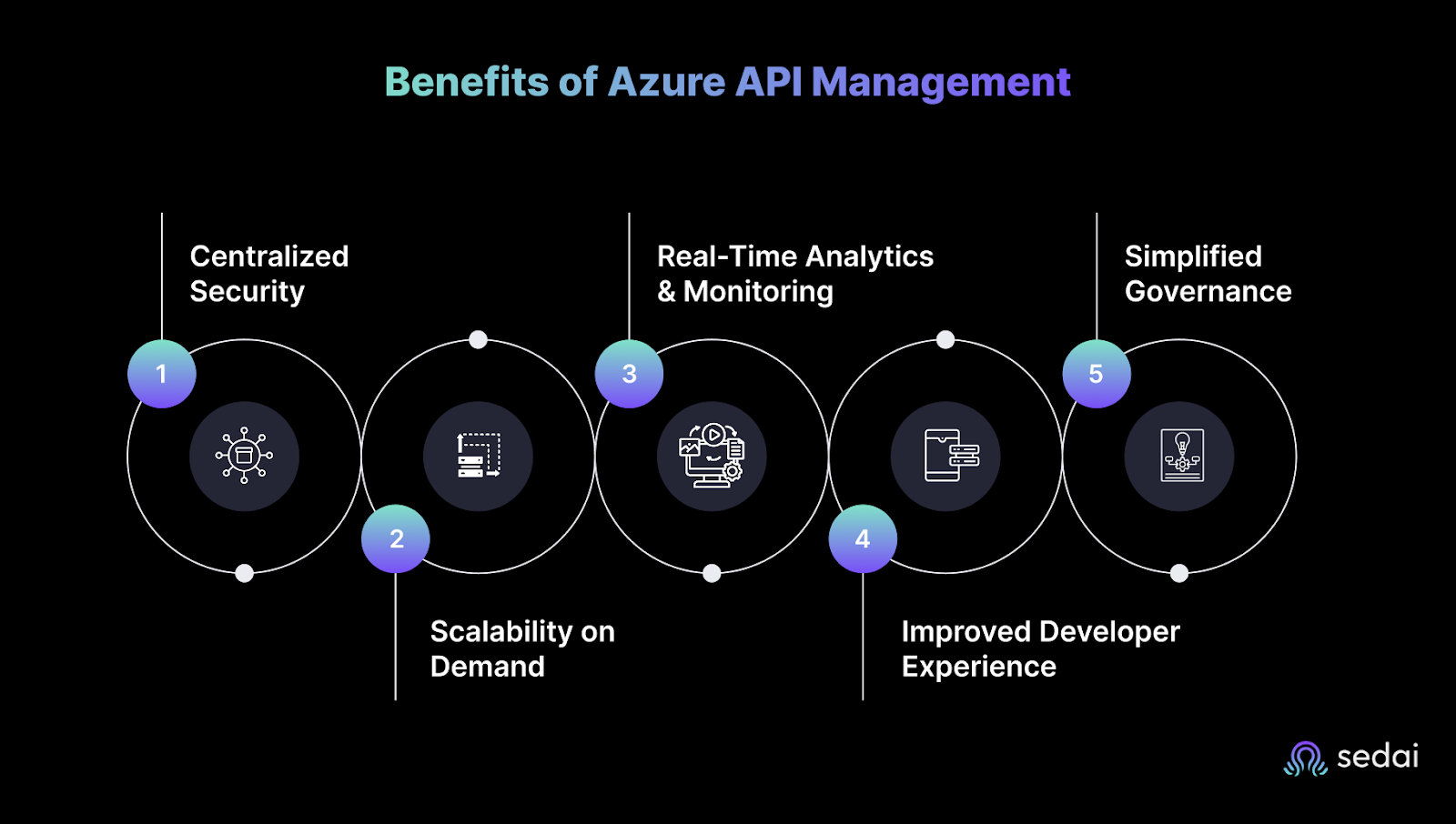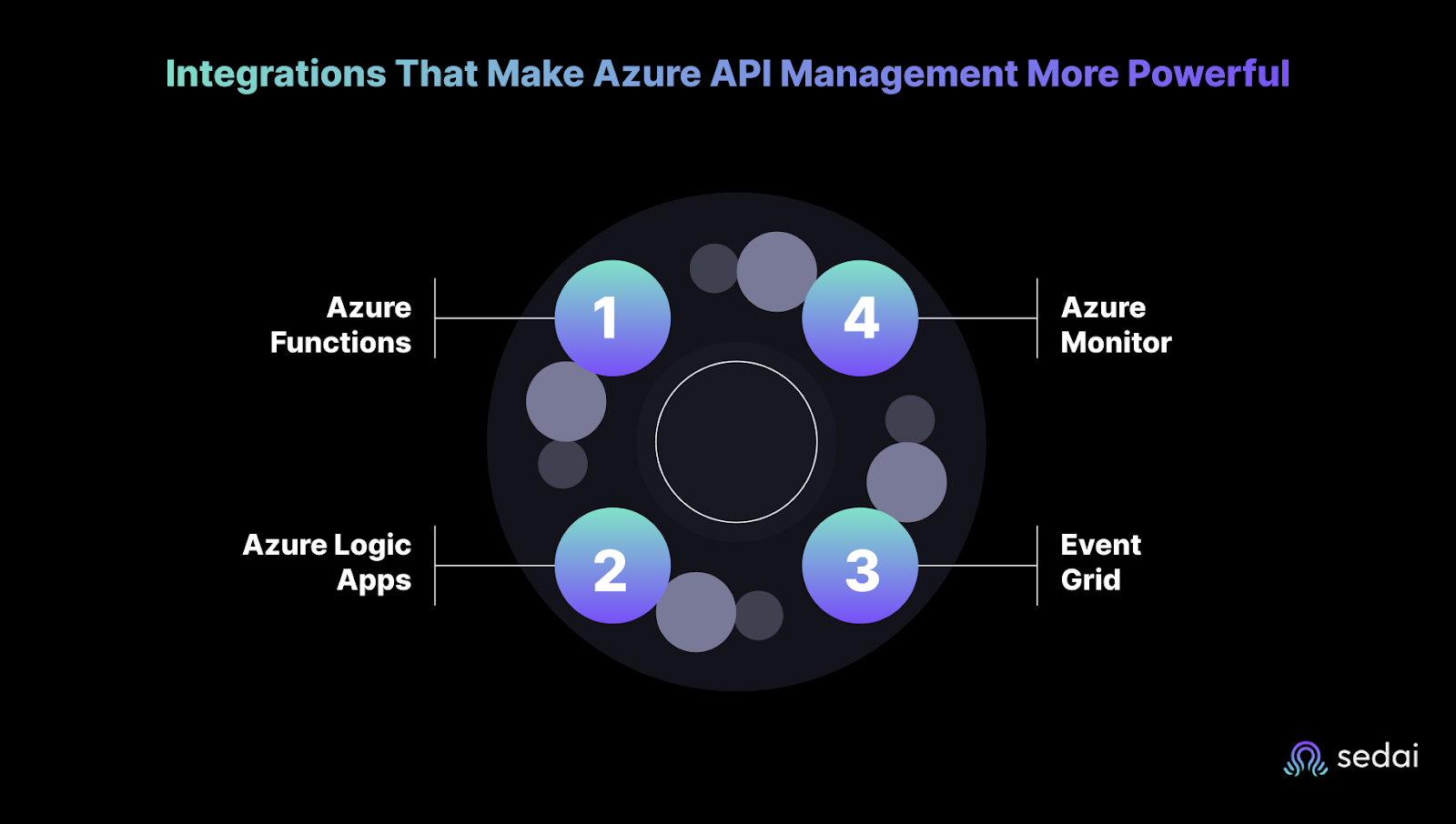Unlock the Full Value of FinOps
By enabling safe, continuous optimization under clear policies and guardrails

November 9, 2025
November 10, 2025
November 9, 2025
November 10, 2025

This guide covers Azure API Management from the ground up, walking you through its core concepts and how to optimize it in real-world scenarios. You’ll see how to design secure APIs, connect with Azure services like Functions and Logic Apps, and manage scaling without overspending. It’s made for engineers and SREs who want to move beyond just setting up APIM and turn it into a reliable, efficient API platform with practical tips and examples. We also explore how Sedai’s AI-driven tools can help you automate monitoring, reduce costs, and keep your API ecosystem running smoothly.
If you’ve worked with APIs at scale, you know the technical debt piles up fast. Endpoints spread across teams. Authorization rules get inconsistent. Monitoring turns into a patchwork of tools. At some point, you’re not managing APIs anymore. They’re managing you.
Azure API Management solves that by giving you one place to publish, protect, and monitor every API across your stack. In this expert guide, we’re not just going to cover what it does. We’ll break down how it works, where it fits in your architecture, and how Sedai can make the whole experience even more efficient.
Azure API Management is the platform that helps you take control of your API ecosystem. It acts as the bridge between your backend services and the consumers, whether they’re internal teams, partners, or external developers.
What sets it apart is how it centralizes common API management tasks: publishing APIs with standardized documentation, applying security policies, enforcing access controls, and collecting usage data. This approach gives you a consistent, repeatable way to manage APIs as your services grow and evolve.
Managing APIs across multiple teams and services quickly gets complicated. Without a solid system, security gaps, scaling issues, and operational headaches are inevitable. Azure API Management is designed to tackle these challenges by streamlining how you secure, scale, monitor, and govern your APIs.

Here’s what that looks like in practice:
Azure API Management offers a comprehensive set of tools designed to handle the technical needs of your API ecosystem:

Azure API Management is built around three core components that keep your API operations organized and scalable.
This is the frontline of Azure API Management. It processes every API request, directing traffic between clients and backend services. The gateway enforces security protocols like OAuth 2.0 and JWT validation, applies rate limits to prevent abuse, and handles request transformations such as converting XML to JSON or injecting headers.
It also supports caching frequent responses to reduce backend load and improve performance. The Self-Hosted Gateway feature allows you to run the gateway outside of Azure—in your data center, on-premises, or other clouds—giving you deployment flexibility without vendor lock-in.
This is the control hub in Azure API Management where you configure APIs, apply policies, and manage user access. Administrators use the management plane to define API versions, set throttling and logging rules, bundle APIs into products for subscription control, and monitor performance and usage. It provides dashboards and APIs for governance, making it easier to automate management tasks and integrate with DevOps workflows.
The developer portal is how Azure API Management connects with your API consumers. It automatically generates interactive documentation from your API specifications (OpenAPI or WSDL). Developers can explore APIs, test calls in the browser, manage subscriptions, and monitor their usage. This portal simplifies onboarding and lowers support needs by providing a self-service experience.
Together, these components separate runtime traffic handling, administrative control, and developer engagement in Azure API Management. This division allows engineering teams to scale securely and maintain APIs efficiently without overlap.

Azure API Management is offered in four main tiers, each designed to fit specific scenarios and scale needs. Choosing the right tier depends on your workload, traffic patterns, and integration requirements.
This tier is free (subject to Azure free account limits) and meant for non-production use—development, testing, or learning. It includes all features so you can build and experiment with your APIs. However, it does not come with an SLA and has limited throughput, so it’s not designed for live environments.
Starting at roughly $150 per month, Basic supports production workloads but with limited scale and fewer features compared to higher tiers. It provides standard API gateway functionality without virtual network (VNET) support, making it suitable for smaller projects or internal APIs where advanced networking isn’t critical.
At about $700 per month, the Standard tier balances price and performance for growing teams and business-critical APIs. It supports VNET integration, enabling secure, private connectivity to backend services. It offers 99.95% SLA, multi-region deployments, and better caching capacity, making it a solid choice for most production use cases.
The Premium tier starts near $2,800 monthly and is geared toward enterprise-scale deployments with stringent reliability and compliance needs. It includes multi-region active-active deployments, advanced VNET injection for complex networking, and the highest SLA at 99.99%. Premium also supports the self-hosted gateway, allowing API gateway deployment outside Azure for hybrid or multi-cloud strategies.
Deployment Options: Besides the Azure-hosted gateways, you can deploy self-hosted API gateways on-premises or in other clouds. This flexibility helps teams that require hybrid models or want to avoid vendor lock-in.
What this means for you: Understanding these tiers helps plan your API management strategy to balance cost, scale, and operational needs. Start with Developer or Basic for smaller workloads, and scale to Standard or Premium as your API traffic and complexity grow.
Also read: Azure Cost Optimization: Strategies for Engineering Leaders (2025 Guide)

Understanding what Azure API Management does is one thing. Knowing where it fits in real projects is another. Here are some common situations where teams turn to APIM:

Azure API Management isn’t a standalone tool. It’s built to integrate deeply with other Azure services, making your API workflows smoother and more manageable.
More teams are turning to platforms like Sedai to get better visibility and control over their Azure API Management setups. Sedai focuses on areas that often cause headaches, like cost overruns, unexpected downtime, and complex dependency chains.
What this really means is Sedai helps you spot inefficiencies and risks before they become problems. For example, it can detect when an API is using more resources than expected or identify configuration gaps that could lead to security issues.
Some of the most practical ways teams use Sedai alongside Azure API Management include:
Sedai isn’t here to replace your current setup. It just adds smarter oversight so your APIs run smoother and efficiently.
Also read: Cloud Optimization: The Ultimate Guide for Engineers
Azure API Management gives you the framework to organize, secure, and scale your APIs. But managing them day to day is a different challenge. Tools like Sedai can step in to help by offering actionable insights on cost, reliability, and security things that are easy to miss when you’re juggling multiple priorities.
If you’re looking for a way to keep your Azure API Management setup running smoothly without the trouble, exploring solutions like Sedai makes sense. It’s about smarter operations, not more work. Get started today.
While both handle traffic, API Management is purpose-built for API lifecycle control (versioning, policies, developer portals), whereas Application Gateway operates at lower network layers (L7 load balancing, WAF). Use both together for full-stack protection.
Absolutely. APIM natively imports OpenAPI definitions (YAML/JSON) to auto-generate endpoints, documentation, and mock responses - no manual rebuilding required.
Overages add up fast. Basic tier charges $3 per extra million calls (vs. $2.50 in Standard). Monitor usage in Azure Metrics and set alerts at 80% capacity.
Sedai's AI ops layer automates what APIM can't, like predictive scaling of backend services, cost anomaly detection, and cross-service failure analysis - all without APIM configuration changes.
No. Only Standard v2+ supports VNET integration, while Premium v2 adds full injection. Consumption/Basic tiers operate in shared Azure networks. Plan your security requirements accordingly.
November 10, 2025
November 9, 2025

This guide covers Azure API Management from the ground up, walking you through its core concepts and how to optimize it in real-world scenarios. You’ll see how to design secure APIs, connect with Azure services like Functions and Logic Apps, and manage scaling without overspending. It’s made for engineers and SREs who want to move beyond just setting up APIM and turn it into a reliable, efficient API platform with practical tips and examples. We also explore how Sedai’s AI-driven tools can help you automate monitoring, reduce costs, and keep your API ecosystem running smoothly.
If you’ve worked with APIs at scale, you know the technical debt piles up fast. Endpoints spread across teams. Authorization rules get inconsistent. Monitoring turns into a patchwork of tools. At some point, you’re not managing APIs anymore. They’re managing you.
Azure API Management solves that by giving you one place to publish, protect, and monitor every API across your stack. In this expert guide, we’re not just going to cover what it does. We’ll break down how it works, where it fits in your architecture, and how Sedai can make the whole experience even more efficient.
Azure API Management is the platform that helps you take control of your API ecosystem. It acts as the bridge between your backend services and the consumers, whether they’re internal teams, partners, or external developers.
What sets it apart is how it centralizes common API management tasks: publishing APIs with standardized documentation, applying security policies, enforcing access controls, and collecting usage data. This approach gives you a consistent, repeatable way to manage APIs as your services grow and evolve.
Managing APIs across multiple teams and services quickly gets complicated. Without a solid system, security gaps, scaling issues, and operational headaches are inevitable. Azure API Management is designed to tackle these challenges by streamlining how you secure, scale, monitor, and govern your APIs.

Here’s what that looks like in practice:
Azure API Management offers a comprehensive set of tools designed to handle the technical needs of your API ecosystem:

Azure API Management is built around three core components that keep your API operations organized and scalable.
This is the frontline of Azure API Management. It processes every API request, directing traffic between clients and backend services. The gateway enforces security protocols like OAuth 2.0 and JWT validation, applies rate limits to prevent abuse, and handles request transformations such as converting XML to JSON or injecting headers.
It also supports caching frequent responses to reduce backend load and improve performance. The Self-Hosted Gateway feature allows you to run the gateway outside of Azure—in your data center, on-premises, or other clouds—giving you deployment flexibility without vendor lock-in.
This is the control hub in Azure API Management where you configure APIs, apply policies, and manage user access. Administrators use the management plane to define API versions, set throttling and logging rules, bundle APIs into products for subscription control, and monitor performance and usage. It provides dashboards and APIs for governance, making it easier to automate management tasks and integrate with DevOps workflows.
The developer portal is how Azure API Management connects with your API consumers. It automatically generates interactive documentation from your API specifications (OpenAPI or WSDL). Developers can explore APIs, test calls in the browser, manage subscriptions, and monitor their usage. This portal simplifies onboarding and lowers support needs by providing a self-service experience.
Together, these components separate runtime traffic handling, administrative control, and developer engagement in Azure API Management. This division allows engineering teams to scale securely and maintain APIs efficiently without overlap.

Azure API Management is offered in four main tiers, each designed to fit specific scenarios and scale needs. Choosing the right tier depends on your workload, traffic patterns, and integration requirements.
This tier is free (subject to Azure free account limits) and meant for non-production use—development, testing, or learning. It includes all features so you can build and experiment with your APIs. However, it does not come with an SLA and has limited throughput, so it’s not designed for live environments.
Starting at roughly $150 per month, Basic supports production workloads but with limited scale and fewer features compared to higher tiers. It provides standard API gateway functionality without virtual network (VNET) support, making it suitable for smaller projects or internal APIs where advanced networking isn’t critical.
At about $700 per month, the Standard tier balances price and performance for growing teams and business-critical APIs. It supports VNET integration, enabling secure, private connectivity to backend services. It offers 99.95% SLA, multi-region deployments, and better caching capacity, making it a solid choice for most production use cases.
The Premium tier starts near $2,800 monthly and is geared toward enterprise-scale deployments with stringent reliability and compliance needs. It includes multi-region active-active deployments, advanced VNET injection for complex networking, and the highest SLA at 99.99%. Premium also supports the self-hosted gateway, allowing API gateway deployment outside Azure for hybrid or multi-cloud strategies.
Deployment Options: Besides the Azure-hosted gateways, you can deploy self-hosted API gateways on-premises or in other clouds. This flexibility helps teams that require hybrid models or want to avoid vendor lock-in.
What this means for you: Understanding these tiers helps plan your API management strategy to balance cost, scale, and operational needs. Start with Developer or Basic for smaller workloads, and scale to Standard or Premium as your API traffic and complexity grow.
Also read: Azure Cost Optimization: Strategies for Engineering Leaders (2025 Guide)

Understanding what Azure API Management does is one thing. Knowing where it fits in real projects is another. Here are some common situations where teams turn to APIM:

Azure API Management isn’t a standalone tool. It’s built to integrate deeply with other Azure services, making your API workflows smoother and more manageable.
More teams are turning to platforms like Sedai to get better visibility and control over their Azure API Management setups. Sedai focuses on areas that often cause headaches, like cost overruns, unexpected downtime, and complex dependency chains.
What this really means is Sedai helps you spot inefficiencies and risks before they become problems. For example, it can detect when an API is using more resources than expected or identify configuration gaps that could lead to security issues.
Some of the most practical ways teams use Sedai alongside Azure API Management include:
Sedai isn’t here to replace your current setup. It just adds smarter oversight so your APIs run smoother and efficiently.
Also read: Cloud Optimization: The Ultimate Guide for Engineers
Azure API Management gives you the framework to organize, secure, and scale your APIs. But managing them day to day is a different challenge. Tools like Sedai can step in to help by offering actionable insights on cost, reliability, and security things that are easy to miss when you’re juggling multiple priorities.
If you’re looking for a way to keep your Azure API Management setup running smoothly without the trouble, exploring solutions like Sedai makes sense. It’s about smarter operations, not more work. Get started today.
While both handle traffic, API Management is purpose-built for API lifecycle control (versioning, policies, developer portals), whereas Application Gateway operates at lower network layers (L7 load balancing, WAF). Use both together for full-stack protection.
Absolutely. APIM natively imports OpenAPI definitions (YAML/JSON) to auto-generate endpoints, documentation, and mock responses - no manual rebuilding required.
Overages add up fast. Basic tier charges $3 per extra million calls (vs. $2.50 in Standard). Monitor usage in Azure Metrics and set alerts at 80% capacity.
Sedai's AI ops layer automates what APIM can't, like predictive scaling of backend services, cost anomaly detection, and cross-service failure analysis - all without APIM configuration changes.
No. Only Standard v2+ supports VNET integration, while Premium v2 adds full injection. Consumption/Basic tiers operate in shared Azure networks. Plan your security requirements accordingly.